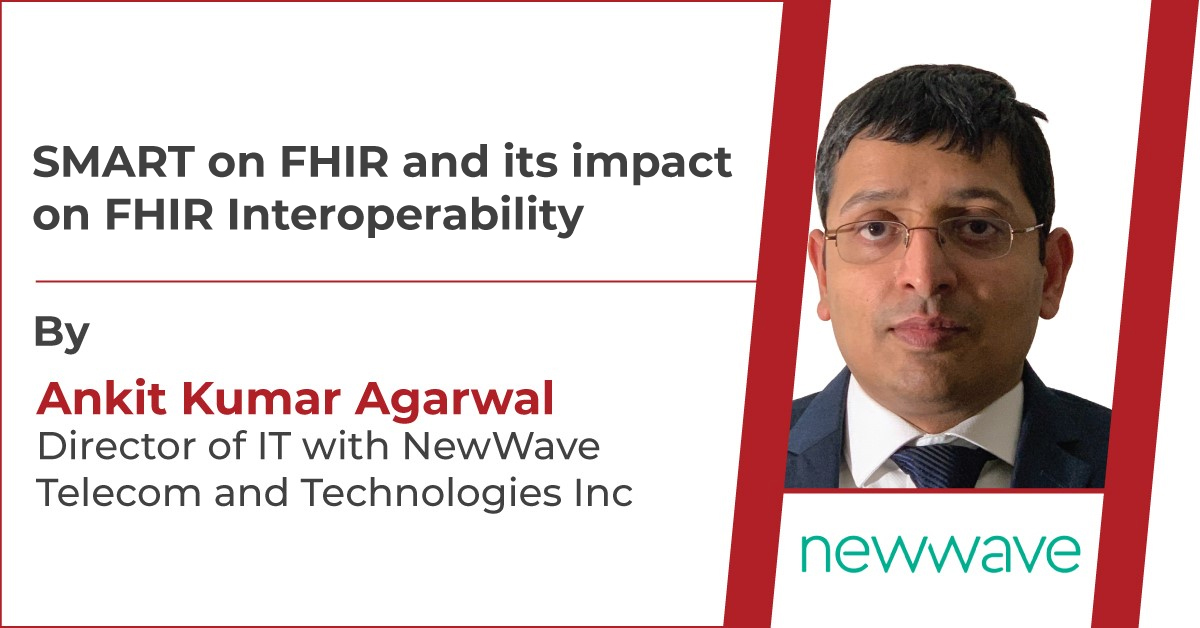
Ankit Kumar Agarwal
Ankit Kumar agarwal is a Wharton Graduate and working as “Director of IT” with NewWave Telecom and Technologies Inc. Ankit is passionate about bringing impactful changes in people’s life and writes blogs to educate people and promote digital Health.
What is SMART on FHIR
SMART on FHIR (Substitutable Medical Apps & Reusable Technologies on Fast Healthcare Interoperability Resources) is a set of open standards and specifications that enables developers to create healthcare applications that can be easily integrated with electronic health records (EHRs) systems. It is built on top of the FHIR (Fast Healthcare Interoperability Resources) standard and allows for the creation of “plug-and-play” healthcare apps that can be used across different EHR systems.
SMART on FHIR defines a set of standard Application Programming Interfaces (APIs) and a security model that allows apps to be launched within the context of an EHR system and to access patient data. This allows the apps to be integrated seamlessly with the EHR, providing clinicians with access to additional functionality and data without requiring them to leave the EHR interface.
Some examples of apps that can be built using SMART on FHIR include:
- Clinical Decision Support
- Population health management
- Patient engagement
- Telemedicine
- Research and analytics
Overall, SMART on FHIR provides a way for healthcare providers to extend the functionality of their EHR systems and to improve patient care by providing access to a wide range of healthcare apps, all of which use the FHIR standard to access patient data.
SMART on FHIR Evolution Over the Years
SMART on FHIR is a relatively new set of standards and specifications, and as such, it has evolved over time to meet the changing needs of the healthcare industry. Some of the key ways in which SMART on FHIR has transformed over the years include:
- Increased focus on security: As the use of SMART on FHIR has become more widespread, there has been an increased focus on ensuring that patient data is protected when using the standard. The security models has been updated and refined to ensure that patient data is protected during transmission and storage.
- Improved support for different EHR systems: SMART on FHIR has been designed to work with different EHR systems, and over time, the standard has been updated to provide better support for different EHR systems, allowing for wider adoption of SMART on FHIR.
- Greater emphasis on patient engagement: With the rise of patient engagement and the increasing importance of giving patients access to their health information, SMART on FHIR has been updated to include better support for patient-facing apps, allowing patients to access their health information in a more user-friendly way.
- Advancements in analytics and AI: With the advancements in analytics and AI, the SMART on FHIR standard has been updated to include support for these technologies, allowing for the development of more advanced healthcare apps.
- Compliance with regulations: The standard has been updated to ensure that the SMART on FHIR solution comply with the regulations such as the December 6th rule, and other regulations related to the sharing of electronic health information.
How SMART on FHIR has Impacted Patient Access API Implementation
The December 6th rule, also known as the “Patient Access API Implementation” rule, requires that healthcare providers and payers make certain information available to patients through a patient access API, which uses the FHIR standard. SMART on FHIR is related to this rule because it provides a framework for creating patient access APIs that can be used to comply with the rule.
SMART on FHIR defines a set of standard Application Programming Interfaces (APIs) that can be used to create patient access APIs. These APIs allow patients to access their health information using the FHIR standard. The patient access APIs created using SMART on FHIR can be used to comply with the requirements of the December 6th rule, which mandate that certain information must be made available to patients via an API that uses the FHIR standard.
Additionally, SMART on FHIR also provides a security model that allows the patient access APIs to be integrated with EHR systems securely and comply with the regulatory requirements for patient data protection.
Overall, SMART on FHIR allows healthcare providers and payers to comply with the Patient Access API Implementation rule by providing a framework for creating patient access APIs that use the FHIR standard and comply with the regulatory requirements for data protection.
Steps to Implement a SMART on FHIR Solution
Implementing a SMART on FHIR solution can be a complex process, but it can be broken down into the following steps:
- Assess your needs: Identify which clinical use cases you want to address and what data you want to make available to patients through the API. This will help you determine the specific requirements for your SMART on FHIR solution.
- Choose an EHR platform: SMART on FHIR is designed to work with different EHR systems, so you will need to choose an EHR platform that supports the SMART on FHIR standard and that meets your specific requirements.
- Develop the application: Develop the application using the SMART on FHIR APIs and standards, and test it to ensure that it works as intended.
- Register the app: Register the app with the EHR platform, so that it can be launched from within the EHR interface.
- Test the integration: Test the integration of the app with the EHR platform to ensure that it works as intended.
- Deploy the app: Deploy the app to the production environment and make it available to users.
- Monitor and maintain: Monitor the app’s performance and make any necessary updates or adjustments to ensure that it continues to meet your needs and comply with any regulatory requirements.
*This article is Peer Reviewed by the Distilinfo Editorial team prior to the publication.*


